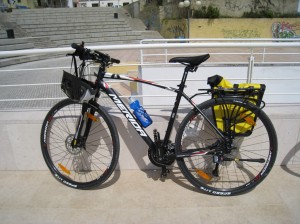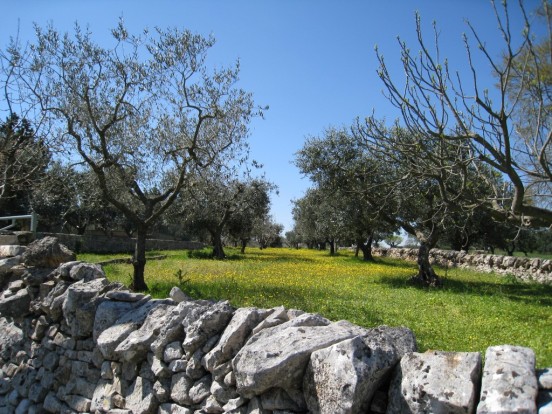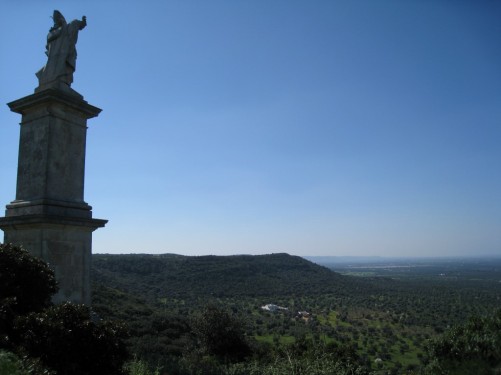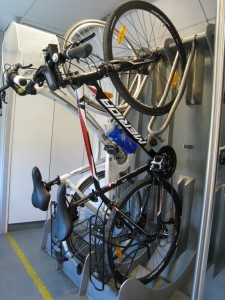Following two previous knee arthroscopies in 2011 and 2013, the pain returned again towards the end of 2014 and by now the solution had become inevitable – a total knee replacement (TKR). After first seeing my GP and then an orthopaedic surgeon at the beginning of the year, the process was put into motion and as a result my cycling plans for 2015 went out the window – but it had to be done. The lead time for the operation was likely to be 18-weeks, which suggested late May, so I decided that beforehand I would take a ‘luxury’ bike tour somewhere in Europe. By luxury I mean the luggage is carried between overnight hotel stops; this was by necessity, as by now my knee was no longer capable of a fully loaded, cycle-camping tour.
Going south had to provide the best chance of finding good weather at this time of the year and, furthermore, I needed to avoid hilly terrain because of my knee. With this in mind and having previously read good things about the far south of Italy, we chose a short break in Puglia (AKA Apulia) and was not disappointed. Flying direct to Bari and then by train to Alberobello, home of the Trulli, we picked-up our bikes. The 140 mile route consisted of 5 daily legs: first to Ostuni, then by train to Lecce before cycling on to the town of Otranto on the Adriatic coast, turning west and riding inland across the ‘heel’ of Italy to Gallipoli on the Ionian coast and then heading back to finish at Lecce.
This region of Italy was once part of the Greek Empire and many other subsequent cultures, which in particular resulted in much spectacular Baroque architecture that is still evident everywhere today. However, my abiding memory of the tour will be the extensive olive groves, interspersed with almond and fig trees, together with widespread viticulture; it seems that this is the largest wine producing region of Italy. Except for a stiff northerly wind the weather was good, with temperatures in the high teens to mid-twenties – perfect for cycling.

Moreover, being Spring the aforementioned trees were in blossom, the fields abounded with every conceivable wild flower and many of the houses were covered by flowering wisteria, altogether producing a truly wonderful landscape through which to cycle. One issue, it has to be said that the road conditions were truly awful, making UK roads look like a cycling paradise.

Much of the region is dominated by the karst geology and scenery of the Murge limestone plateau. The resulting landscape is dominated by attractive white or creamy white limestone houses, walls, towers, castles and churches everywhere, as well as forming natural limestone topography and coastal cliffs. Whilst the region is not unduly hilly, the ride from Alberobello to Lecce runs along the north-south escarpment of the Murge plateau, bordered to the east by the coastal plain and to the west by the Itria valley, with frequent but short hilly sections. The initial part of the route from Otranto to Gallipoli also rises considerably. Ordinarily I would describe this as moderate terrain but with my bad knee I was just at the limit and therefore pleased not to be carrying luggage on this occasion.

This type of organised cycle touring was a first for me. The ride was arranged through a British agent but on-the-ground Apulia Bike Tours were responsible for the bikes, hotels and all the logistics and provided an excellent service. The Merida bikes were brand new, which though OK did not come without issues: in my opinion the saddle and the tyres were not up to the job. I can honestly say that in over 50 years of cycling, the saddle was the most uncomfortable I have ever experienced and caused me great discomfort throughout – it was cheap and literally not fit for purpose. After getting a puncture when arriving at Gallipoli, I also had the chance to inspect the tyres which in a word were also inadequate; it was interesting to see other hire bikes when at our Lecce hotel using Schwalbe Marathons, which would have been much more suitable for this type of cycling.

We were supplied with a spare inner-tube, pump, tyre levers and a multi tool – which were just about adequate for basic problems – and one Ortlieb rear pannier and a bar bag to carry daily stuff. I did take a few small additional tools and, at the last moment, we purchased a small rear and front light LED pack of lights in the UK, which turned out to be very useful. We had not been informed if lights were supplied and on arrival discovered they were not but were told: “don’t worry you won’t need them”. Well we did need them on a number of occasions and I consider their omission from the list of basic equipment to be unsafe and unacceptable.
Finally, for navigation we were given a bound A5 size map book, consisting of the route printed on Google Maps and a Mio Cycle 300 GPS computer, with the daily routes pre-loaded. This was my first experience of using GPS, which started well but by the last day failed completely, thus confirming my previous concerns about such equipment. Such was the lack of road detail in the map book that any problems with the GPS could and did prove a major problem; fortunately I had previously downloaded the Map Me offline Italy map app, which together with my smartphone’s GPS provided an invaluable mapping tool. Travelling slowly as a result of my knee and in order to just take in the ride and places, the Mio GPS battery ran also out after about 5-hours. Bottom line: the Mio GPS and map book were not good enough for this type of tour.
As I now sit writing this post I am convalescing from the knee surgery, which to my surprise took place just two days after returning from Italy, much sooner than anticipated. It was a significant operation that is still quite painful and will take months to recover from. The trip to Puglia will likely be my cycle touring swan song for most of 2015 but, as intended, turned out to be an excellent pre-op treat, although my touring tan and the fitness achieved on the tour are already fading rapidly. In the meantime, memories of the simple but beautiful countryside of Puglia are providing a much needed boost to my morale and an incentive to get touring again as soon as I can.

Day-1 Redhill to Alberobello
Considered ‘the capital’ of trulli country, we started the tour at Alberobello, which was not an easy place to get to. The BA flight from Gatwick to Bari was straightforward but the subsequent train journey was not without issues, most notable being that most of the trains and platforms at the stations did not indicate destinations or times. Being Anglo Saxon I find the Italian laissez faire attitude to such information, timing and life in general difficult to adjust to but it usually works – eventually!
The trullo (pl trulli) is a 19th century, small dry-stone hut made of limestone with a conical roof, often painted white and is ubiquitous in this area of Puglia. Such is the widespread occurrence of these unusual and attractive buildings in Alberobello that the town has been made a UNESCO World Heritage site. We stayed in a trullo the first night, which thankfully has now been brought up to 21st century standards with air conditioning and other mod cons.

Day-2 Alberobello to Ostuni: 24 miles
Today marked the real start of the tour with our bikes and equipment delivered to the trullo early in the morning. After familiarising ourselves with the equipment and despatching our luggage to the next hotel, we had a brief look around Alberobello before setting off for Ostuni.

The route took the back roads most of the way along the top of the Murge limestone plateau, with occasional views of the Itria valley to the west and towards the end shortly before Ostuni, extensive views over the eastern coastal plane and along the Murge escarpment.

Local erosion of the plateau has resulted in small but frequent hills that cumulatively became quite tiring during the day. The first half of the ride meandered up and down the limestone topography through fields of olive groves, almond trees, fig trees and the inevitable trulli, overall making a very pleasing and enjoyable landscape.

Though mostly rural the route was punctuated by two ancient hill towns, Locorotondo and Cisterino. Both are built mainly of gleaming white limestone and divided by numerous, very narrow, largely traffic free lanes interspersed, needless to say, with many churches – altogether producing a wonderful scene of bygone times and a great atmosphere.


Ostuni is another very white but larger limestone town, built around and over a hill that stands conspicuously out of and thus looks over the coastal plain. My navigation is usually good but because of the irregular road system that wound around Ostuni with no obvious logic, and as the GPS route did not go as far as the hotel and the map book lacked necessary detail, finding the hotel proved difficult. However, after going round in circles for some time we eventually found it on the lower slopes of the hill on the eastern outskirts of town, with magnificent uninterrupted and unspoilt views towards the Adriatic Sea about five miles away; most other places would be developed with high rise hotels along such a coast but here it is mostly olive groves and vineyards.


Day-3 Ostuni to Lecce: 5 miles

Being nearly 50 miles from Ostuni, today we took ourselves and the bikes by train to Lecce where we spent the rest of the day sight-seeing in the old town. Looking at old Lecce and its Baroque architecture was worthwhile but personally I would have preferred more cycling.

Day-4 Ostuni to Otranto: 34 miles
The route east out of Lecce to the coast was complicated but my new friend the Mio Cyclo 300 GPS worked flawlessly on this occasion. The first five or so miles were frankly grim – very poor, run down housing and generally filthy with discarded rubbish everywhere; throughout the trip fly tipping was sadly very common, with the roadside often covered with extensive litter and various unwanted scrap. Notwithstanding, soon thereafter the scenery turned to olive groves and fields of colourful wild flowers but with little habitation until we came upon Acaya.
Located some three miles from the Adriatic coast, Acaya is a 16th century fortified village, at the heart of which is a magnificent castle, all built in white limestone. Surrounded by a moat and castle walls, the rectangular limestone streets divided the village buildings into islands. The town was very quiet, dead in fact, but it was fascinating to cycle around; like Locorotondo and Cisterino, with the passage of time the narrow limestone surfaced streets have become polished and would probably be very slippery in the wet – fortunately today the sun shone brightly.


From Acaya the route turned south, mostly taking small back roads and lanes that continued to wind through more olive groves towards the coast. By now numerous, round dry stone limestone towers were dotted amongst the fields and olive groves. Subsequent research suggests these may be Specchia, though I am not certain, and seem to be used for a variety of reasons in particular as look out posts and burial mounds from as far back as the Neolithic period.

Finally we reached the coast at Santa Foca, which consisted of limestone cliffs interspersed with sandy beaches and an aquamarine coloured sea. It was tempting to go swimming but I put this off until later in the day.

The coast from here to Otranto became quite touristy, though not excessively so, but most of the cycle route was now just inland. Just south of Torro dell’Orso the programmed GPS route ran into trouble as the track became impassable where it was being dug up to lay utility pipes. We were able to navigate around this obstacle for the next few miles but the GPS tracking never seemed to recover from the diversion.

With some similarity to Dubrovnik on the other side of the Adriatic but less touristy, Otranto was probably the best stopover on the tour. Located within a large bay, the original old walled town is on the southern side of the bay with beaches and cliffs along the middle and northern sections. Our hotel was excellent and with a small sandy cove just 200 metres down the road, I at last managed to swim in the Adriatic. Of all the places we visited it is probably the only one I would go back to – they have an annual jazz festival, so maybe I will one day?
Day-5 Otranto to Gallipoli: 37 miles
Today’s ride crossed the ‘heel’ of Italy from the Adriatic to the Ionian Sea, also known as the Salento region. It was a long ride, initially climbing high through pleasant but by now somewhat boring olive groves – the appeal wears off a little after the first 10,000 hectares! At the top of the climb we came across a lot of activity and as we rode on found ourselves in the middle of a marathon competition. Shortly thereafter the section from Cursi to Melpignano was dominated by numerous large quarries, old and new, from which much of the limestone we had seen had obviously been taken over many centuries. Later in the afternoon the GPS started to play up again but eventually we rolled into Gallipoli, where in the final half mile I managed to puncture; the road surface even in town was awful so it did not entirely come as a surprise.
Day-6 Gallipoli to Lecce: 39 miles
Before heading back to Lecce we cycled around the old town which sits on a promontory which is situated beyond the newer part of town where we had been staying.

Most noticeable today was a northerly wind that would be in our faces all day which, together with the more open and often bleak agricultural landscape, made most of the ride quite unpleasant. With a rail connection between Gallipoli and Lecce, I would personally exclude this section from the itinerary and use the train to return to Lecce, instead incorporating more of the southern coastal peninsular into the route.
On top of it all, today the GPS finally went mad. When I knew we were definitely on the track I rebooted and reset the computer many times but at no time did it recognise the location or the track and instead tried to take us on a wild goose chase to some other unknown point, which I ignored. Luckily using the map book and my smartphone maps and GPS, I managed to plot a route back to Lecce but this was the final straw – in my opinion there is no substitute for a good map and the ability to use it.
Day-7 Lecce to Bari
The bike tour finished in Lecce where we left the bikes to be picked up and today took the train back to Bari in order to catch the flight home the following day. Once again we had to deal with the Italian railway’s lack of information but we had all day and eventually made it to our very nice hotel in Bari.
Day-8 Bari to Redhill
An uneventful BA flight home to Gatwick marked the end of an enjoyable trip and I was ready for my operation, at last.
STATS – MAPS – STUFF
Tour: 15th to 22nd April 2015, 8-days
Total Mileage: 139 miles
Maps: Michelin 1:200,000 Map 363 Puglia + Google maps & Mio Cyclo 300 GPS programmed computer
Accommodation:
Alberobello – Hotel Trullidea Resort
Ostuni – Hotel Relais Saint’ Eligio
Lecce – Eos Hotel
Hotel Degli Haethey
Gallipoli – 33 Baroni Hotel
Bari – VOI Oriente Hotel


Hi there. Thanks for the great post on Puglia. I’m thinking of heading there in April/May 2017 on a bike tour with my girlfriend, two bikes, and a cargo trailer, starting in Brindisi or Lecce and heading around the south coast road to Gallipoli with some inland detours along the way. Could you give an idea of traffic volumes around that time of year? I know your route didn’t include much coast, but I’m particularly wondering about traffic on that coast road around the heal – any thoughts would be very much appreciated.
Many thanks
Luke
LikeLike
Thanks for your kind comments Luke. Except in the largest towns I don’t recall traffic being a problem in fact I’d go so far as to say the roads were fairly quiet. Furthermore, thinking about it, they and the drivers were noticeably better than those in the north of Italy who are, in my humble opinion – crazy + easily the worst I have ever come across. That’s the appeal of the south, which is much more laid back + at the time of the year you’re going it will definitely be quiet; you may want to consider this when planning accommodation or camping. I find using a good map and sticking to the the back roads when on a bike usually guarantees a decent ride and less traffic. If you can get something at 1:50,000 it’s ideal though we used satnav and the Michelin 1:200,000 map. Hope that helps? regards, Graham
LikeLike